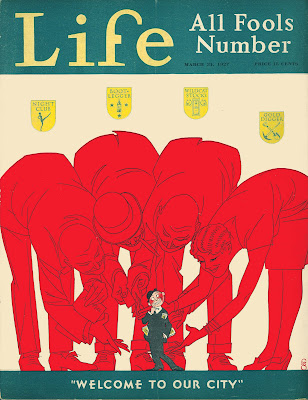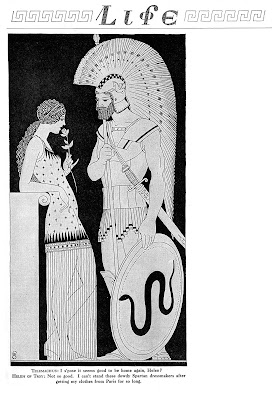Part One: Cartoons, comics strips and "cartoonettes"
 |
Drop cap from the book review column, "Life and Letters",
March 10, 1927. |
he
three St. Patrick's Day covers by Fred G. Cooper in the previous post, along with the two
New Year covers posted in December, are a good example of what Leslie Cabarga has called Cooper's "self-consciously unself-conscious" approach to illustration. "[T]hroughout his life he did not limit himself to a solitary artistic identity," Cabarga writes in
The Lettering and Design of F. G. Cooper.* "Yet no matter the style or technique employed his work was always easily identifiable."
F. G. Cooper arrived in New York City in 1904, and began a lengthy career as a freelance designer and illustrator that would include a fifty year association with New York Edison (later ConEd) , creating
posters, ads, calendars -basically a visual identity - for the company. He did ads for
Westinghouse,
posters for the
War Department, illustrated books and magazine articles and designed alphabets (though not, as is often assumed,
Cooper Black.) He was a founding member of the
American Institute of Graphic Arts (AIGA). And he contributed to
Life, from 1904 on into the early 1930's, when he served briefly as the art editor during the final years of Charles Dana Gibson's ownership of the magazine.
Throughout most of the Teens Cooper's main contribution to
Life consisted of spot drawings, "cartoonettes" as he called them, for the editorial page. The use of spots on this

page was nothing new but none of the artists that had taken on the assignment before seemed as comfortable as Cooper working in such a small space (one 12.5 pica wide column, 5 lines deep.)
The tiny drawings were, for the most part, only tangentially related to the article they were supposed to be illustrating. They could be - and were - used over and over again well into the Twenties, for a wide range of topics, and yet they don't seem at all generic or like clip art.
 October 12, 1911
October 12, 1911 May 28, 1914
May 28, 1914 August 13, 1914
August 13, 1914 July 30, 1914
July 30, 1914Beyond the editorial page "cartoonettes", which appeared weekly, there seems to have been only an occasional panel cartoon or cover contributed by Cooper in the 1910s. There's undoubtedly more to be found, but probably not a lot more, which is too bad. The "Naughty Wag" cartoon below is a knockout on so many levels, I wish I had a dozen more like it to show.
 December 8, 1910
December 8, 1910 September 30, 1915
September 30, 1915 March 16, 1916
March 16, 1916In the 1920's Cooper's work appeared much more frequently. He created a series of comic strips that displayed not only his unique take on this form, but his skill as a writer and his sense of humor as well. He also designed a number of house ads for the magazine's subscription offer page. In 1928
Life published a Vaudeville number which was illustrated exclusively by Cooper, the only time an entire issue was turned over to one artist. (This will be the subject of a future post.) Whether he was contributing spots, panel cartoons or comics, Cooper somehow managed to make the entire page he was on look good. But it's the wide variety of covers that Cooper did that show off his skills as a graphic designer, letterer, cartoonist and illustrator best. Some of those will be posted next week.
 March 18, 1920
March 18, 1920 March 13, 1924
March 13, 1924 March 13, 1924
March 13, 1924 August 21, 1924
August 21, 1924 October 2, 1924
October 2, 1924 September 23, 1926
September 23, 1926 December 2, 1926
December 2, 1926 November 18, 1926
November 18, 1926 October 14, 1926
October 14, 1926 June 3, 1926
June 3, 1926 April 7, 1927
April 7, 1927 August 25, 1927
August 25, 1927 August 25, 1927
August 25, 1927 May 26, 1927
May 26, 1927 June 2, 1927
June 2, 1927 August 25, 1927
August 25, 1927



 March 31, 1927
March 31, 1927*
This book is loaded with great examples of F. G. Cooper's artwork, and is worth it alone for the section of monogram designs FGC created for, among many others, Milton Caniff, Freeman Gosden and Dwight Eisenhower.







































 page was nothing new but none of the artists that had taken on the assignment before seemed as comfortable as Cooper working in such a small space (one 12.5 pica wide column, 5 lines deep.)
page was nothing new but none of the artists that had taken on the assignment before seemed as comfortable as Cooper working in such a small space (one 12.5 pica wide column, 5 lines deep.)


























